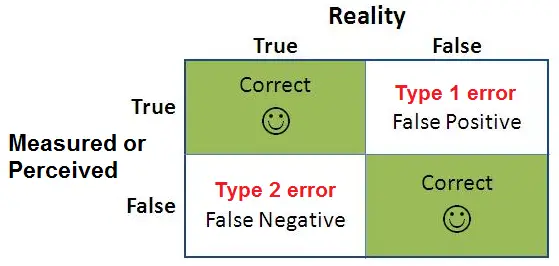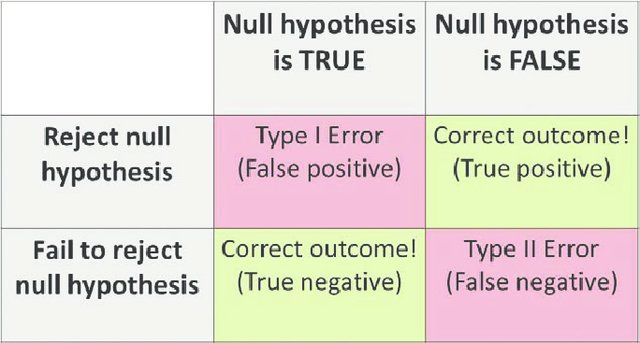Table of Contents
Type I Error
What is Type 1 error?
Type 1 error in tests of statistical hypotheses, refers to the mistake that is caused by refusing to accept a null hypothesis even though it’s true. Type 1 errors occur when a hypothesis that ought to be accepted was rejected. Type I errors are identified by an (alpha) also known as an error. It is also known as the significance level that the tests. This type of error can be described as a false negative error in which it is impossible to prove the hypothesis due to an error in the test.
Null hypotheses are used to assert that there isn’t any relationship between two variables, and that the causality connection between the two variables when it is present is due to chance. Type 1 errors occur where the null hypothesis gets rejected, even when there isn’t any connection between the two variables. Due to this mistake it is possible that the researcher will conclude that the hypothesis is true even though it isn’t.
Causes of Type 1 error
- The error of Type 1 occurs by the fact that something other than the variable that is at fault affects the other that produces an outcome that is in support of the Null Hypothesis.
- In these circumstances the results appear to be due to more reasons other than luck, but actually, it was due to chance.
- Before a hypothesis is evaluated the probability of its test is determined as a threshold of significance meaning that the hypothesis is evaluated while taking a chance that the null hypothesis will be dismissed even when it’s valid.
- The error of type 1 may be due to luckor the level of significance established prior to the test, but without taking into consideration the duration of the test and the size of the sample.
Probability of type 1 error
- The likelihood of a Type I error is usually established in advance and defined as the degree of significance that is tested by test the hypotheses.
- If the Type I error is fixed at 5 percent, that implies that there are around 5 percent chance the H0 hypothesis, the null hypothesis, will be rejected if it’s valid.
- The probability or rate of a type 1 error is represented by a and is also known as the importance level of the test.
- The possibility exists to decrease the error of type 1 by an exact size of the sample, but in doing this, the likelihood of error type II increases.
- There is a balance between the two errors, where decreasing the likelihood of one error can increase the chance of the other. It is impossible to eliminate both errors at the same time.
- So, based on the type and the nature of test researchers have to determine the proper degree of error type 1 by analyzing the impact of the mistakes.
Some examples of the Type 1 errors
- To do this, let us imagine that an athlete is trying to determine the correlation between wearing brand new footwear and amount of victories for his team.
- In this case, if you find that the amount of victories his team has is higher when he was wearing the new shoes greater than the amount of wins that his team would have or not, he could consider the other hypothesis and decide that there’s some connection.
- However, the outcome of his team could be affected by luck instead of his shoes, which could result in a an error of type 1.
- In this instance He should have believed in the non-sense because the success of a team may be through luck or chance.

Type II error
What is the Type II error?
Type II error refers to the error that happens in the case of accepting the hypothesis despite the fact that it’s not. In simple terms, Type II error means acceptance of the hypothesis even though it shouldn’t be accepted. The error of type II results with a fake negative outcome. In this way, it is the mistake of not being able to take a different theory when the researcher isn’t equipped with enough capacity. The type II error is indicated by the letter b (beta) and can also be known as beta error.
It is used to assert that there isn’t a connection between two variables, and that the cause-effect relation among two factors, in the event that it is present it is caused by luck or chance. The error of Type II occurs in situations where the hypothesis of nullity is valid because the relationship between the two variables is the result of luck or luck and even if there exists a relationship between the two variables. Due to this mistake it is possible that the researcher will be tempted to believe that the hypothesis isn’t working even though it could.
The causes of error Type II
- The most common cause of Type II errors, which is similar to an Type II error, is the insufficient effectiveness of the test.
- This happens when the statistical power isn’t as strong and leads to an error of Type II.
- Other factors, such as the sample size, can impact the outcomes of the test. Other factors, such as the size of the sample, could also affect the results.
- When a smaller sampling sizes are selected when a relationship is established among two factors being analyzed could not be significant even if it is.
- The researcher could conclude that the connection is a result of chance and therefore reject the alternative theory, even though it’s valid.
- It is crucial to choose the right sample size prior to starting the test.
Probability of Type II error
- The likelihood of making the Type II error is calculated by subtracting the strength to test by.
- If the Type II error is fixed at 2 percent, that implies that there are two times in 100 the chance that the null hypothesisH0 is accepted even if it isn’t true.
- The probability or rate of error type II is illustrated by the symbol b. It is sometimes referred to as mistake of the type 2.
- You can lower the risk for Type II error by increasing the importance of the test.
- In this situation there is a higher chance of not accepting the null hypothesis when it’s true increases, which decreases chances of accepting the null hypothesis if it isn’t.
- However, because Type I error and Type II errors are linked decreasing one will increase the likelihood for the next.
- So, based upon the type of test it is essential to figure out which error is least detrimental for the exam.
- To clarify, a an error of type I involves the effort and time of testing the chemicals that are used in the medicine that ought to have been accepted , while type II error entails the possibility of a large number of patients being poisoned, it’s sensible to choose this type of error instead of the type II.
Examples of type II error
- To do this, let us consider a scenario in which the shepherd is convinced that there’s no wolf living in the village, and he awakes at night for five consecutive nights to check whether the wolf is actually there.
- If he does not see any Wolf for five nights then he could conclude that there isn’t any Wolf in the village in which there is a wolf and then attack at night six.
- In this scenario, when the shepherd accepts that there is no animal exists, a kind II error is created where the shepherd is in agreement with the null hypothesis even though it’s not the case.

Differences Between Type I Error and Type II Error – Type I Error vs Type II Error
| Base for comparison | Type I error | Type II error |
| Definition | Type 1 error, which is a part of the statistical test of hypothesis, refers to the error that results from refusing to accept a null hypothesis even if it is real. | Type II error is an error that is caused in the case of a null hypothesis being accepted even when it isn’t true. |
| Also known as | Typ I errors are equivalent in false positive. | The error of Type II is comparable to the false negative. |
| Meaning | It is an untrue rejection of an actual theory. | It’s the wrong acceptance of an untrue idea. |
| Symbol | Type I errors are identified by the letter. | Type II errors are identified by the letter b. |
| Probability | The likelihood of making an error is the same as the degree of significance. | The likelihood of making a Type II errors is equal to one times its power. |
| Reduced | It is possible to reduce it by reducing the amount of importance. | It is possible to decrease the significance by increasing its importance. |
| Cause | It’s the result of luck or luck. | This is due to the smaller sample size or a weaker test. |
| Is it a thing? | Type I errors are similar to the false hit. | Type II errors are like a missed. |
| Hypothesis | The error of Type I is often caused by the rejection of this null hypothesis. | Type II errors are caused by rejecting the alternative hypothesis. |
| When does it occur? | It occurs when the tolerance levels are set too loose. | It happens when acceptance standards are too strict. |
